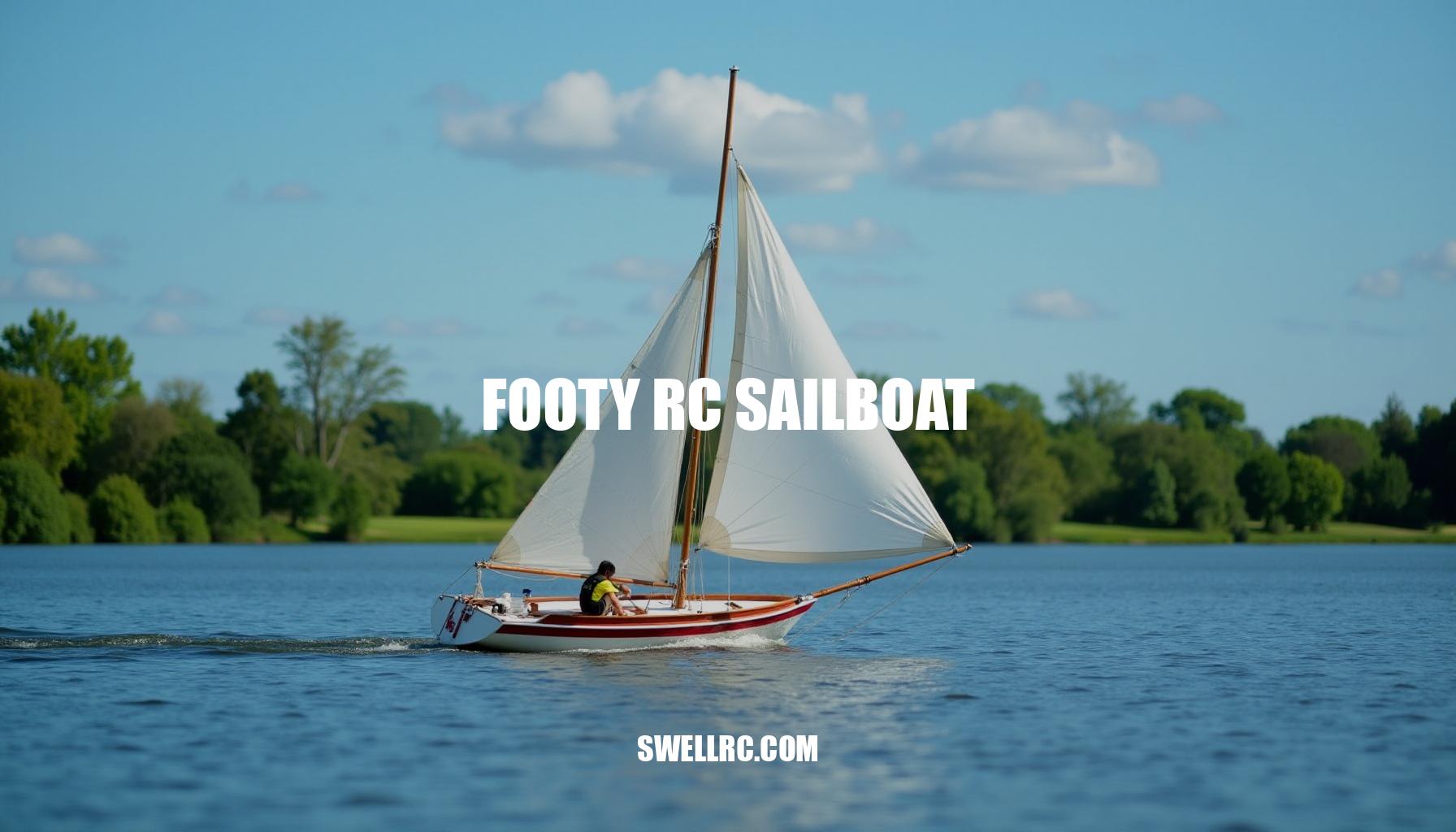The Ultimate Guide to Footy RC Sailboats: Miniature Racing at Its Finest
I still remember the moment I first saw a Footy slice through the pond—twelve inches of hull carving perfect tacks while the big boats stalled behind. It was a deceptively simple micro marvel, this Footy RC class sailboat, that effortlessly combined accessibility with surprising performance. As an enthusiast drawn to RC sailboats, I was immediately hooked: here was a mini sailboat racing experience approachable enough for beginners, yet endlessly tunable to satisfy even the most seasoned veterans.
Over time, I dove deep into the design choices, building techniques, and tuning insights that make these radio-controlled boats truly shine. In this journey through the vibrant RC marine hobby, I’ll share hands-on lessons from testing and tinkering, including racing strategies, cost considerations, and how the broader world of radio-controlled boats sharpened my Footy skills. Whether you’re just discovering micro RC sailboats or looking to up your mini sailboat racing game, this guide will steer you through every facet with enthusiasm and technical confidence.
What Makes a Footy RC Sailboat Unique
The Footy RC class is a fascinating category of compact RC sailboats defined by the “Measurement box rule,” which mandates that these micro sailboats fit within a box roughly 12 x 6 x 12 inches (305 x 153 x 305 mm). This strict size limitation challenges designers and hobbyists to prioritize clever Footy hull design and meticulous tuning to extract maximum performance out of a tiny, manageable vessel.
Footy sailboats are characterized by several hallmark features:
- Compact hulls that lend themselves to incredible portability and agility on the water.
- Ballast-bulb keels which provide stability and allow for powerful righting moments despite the boat’s small size.
- Light rigs, often featuring swing rigs like the McRig or simple sloop configurations, designed to efficiently capture wind without adding unnecessary weight.
- Minimalist radio gear that keeps the boat light and responsive.
| Aspect | Footy RC Class | RG65 | Bigger RC Sailboats |
|---|---|---|---|
| Size | ~12 inches hull length | 65 cm hull length | Often over 1 meter+ |
| Handling | Extremely agile with tight turning radius | Longer waterline enables smoother glide | Stable, steady on the water with more presence |
| Portability | Highly portable, fits in a backpack | Portable but larger | Less portable, often require transport cases |
| Performance sensitivity | Small setup changes (mast rake, sail camber, keel depth) have large effects | Moderate impact of tuning | More stable and forgiving, tuning still important |
Compared to other classes like the RG65, which benefits from a longer waterline and an elegant glide, or the bigger models that emphasize stability and presence (see here), the Footy excels in delivering surprisingly quick acceleration and razor-sharp maneuverability within just a foot of hull length. This makes it perfect for tight courses and dynamic racing found in many RC regattas and popular at RC sailing clubs worldwide.
In essence, the Footy RC class showcases how much performance can be squeezed into a tiny sailboat through Footy hull design innovation and fine-tuned setups, making it a favorite for enthusiasts who love technical challenge combined with portability and fun on the water.
Building and Tuning a Footy RC Sailboat
Embarking on your RC sailboat journey begins with selecting the right path. For those seeking a fast start, exploring sailboat kits is invaluable. These kits provide tested components and streamlined assembly.
Alternatively, DIY enthusiasts might grab DIY Footy RC sailboat plans from the community repositories, offering customization and a deep dive into craftsmanship.
Next, make core design decisions. Choose between a swing rig (McRig), renowned for its simplicity and self-tacking efficiency, or a classic sloop rig offering better control but requiring finer tuning. When sizing the fin and bulb, balance stability and performance—a deeper bulb adds ballast but may reduce agility.
Servo selection is pivotal. A micro rudder servo paired with an arm works well for precise steering, while a drum sail servo with sufficient torque manages sail trimming effectively. Proper servo alignment ensures smooth operation and responsiveness.
Placing the battery and receiver low and close to the centerline is essential for optimal ballast and keel setup. This positioning keeps the center of gravity balanced and enhances sailboat stability in varying winds.
Alignment and tuning steps include:
- Mast step position: Place it to achieve ideal mast rake.
- Mast rake: Slightly raked aft to balance helm.
- Sail twist: Allows efficient airflow; adjust outhaul and vang.
- Vang and outhaul basics: Control leech tension and foot shape.
- Smooth rudder geometry: Minimize binding or slack for crisp control.
Through experience, I’ve tackled several challenges. Leak prevention is critical—applying grease on pushrods and ensuring well-sealed hatches avoids water ingress. Servo calibration often demands patience to achieve neutral endpoints.
Balancing helm to prevent persistent weather helm or lee helm may require incremental tweaks in mast rake or sail trim.
One breakthrough I cherish: “After countless hours adjusting sail angles, a half-degree of mast rake finally unlocked neutral helm in a breeze.” Such fine tuning elevates your RC sailing experience from hobbyist to maestro.
| Component | Recommendation | Notes |
|---|---|---|
| Sailboat Kits | Proven brands with comprehensive instructions | Offers jumpstart for beginners |
| Rig Choice | McRig for simplicity; Sloop for control | Depends on sailing style and skill |
| Servo Setup | Micro rudder servo + arm; Drum sail servo with torque | Ensure smooth servo alignment |
| Battery/Receiver Placement | Low and near centerline | Optimizes ballast and keel setup |
| Sails | Lightweight, durable sail material | Improves performance and longevity |
Pre-Race Tune-Up Checklist
For every beginner preparing for an RC race, a thorough pre-race checklist ensures your boat is ready for optimal performance on the water. Follow these eight essential steps to nail your Footy tuning and RC race prep:
- Verify watertightness: Check hatch seals and pushrod exits carefully, then perform a quick bathtub test to confirm no leaks.
- Battery check: Ensure your battery pack is fully charged, verify voltage levels, and set your failsafe to avoid surprises.
- Radio calibration: Adjust endpoints for sail and rudder, set neutral trim, and conduct a range test to ensure responsive control.
- Mast rake and tension: Match your mast rake to the day’s wind conditions by selecting your A/B/C rig accordingly, and set vang and sheet marks precisely for ideal sail trim.
- Keel and rudder alignment: Confirm true tracking by removing any play in the rudder, an essential step for precise steering.
- Balance/CG: Verify your center of gravity per the designer’s specifications—usually near the keel’s leading edge—and ensure the boat floats level on its waterline.
- Sails: Check that the camber is smooth with no wrinkles at the luff, and that battens are seated properly for optimal aerodynamics.
- On-water shakedown: Before race start, execute two tacks, two gybes, and practice a quick stall recovery to test your setup.
Following this pre-race checklist will greatly improve your RC race prep by fine-tuning crucial elements like mast rake, rudder alignment, and sail trim to boost your performance and confidence on race day.
Racing the Footy – Speed, Strategy, and Skill
There’s an undeniable buzz at the Footy start line—boats poised like sprinters on the cusp of surge, sails twitching with anticipation, skippers scanning for the perfect puff. In the world of Mini sailboat racing, nailing laylines on a tight windward–leeward course sparks a rush of satisfaction that only true RC regattas devotees understand. Unlike offshore powerboats, where raw thrust and line choice dominate (see RC offshore powerboats), or outriggers focusing on brute force and momentum (learn more at RC outrigger boat kits), Footy racing demands finesse, precise timing, and savvy rig selection.
The short waterline of Footies makes every wind shift and puff feel amplified—each subtle change tested against your ability to keep the boat powered and minimize unnecessary tacks. Anticipating headers is crucial; every maneuver costs speed, and in such tight, tactical battles, smooth rudder inputs can mean the difference between clean air advantage and a scrubbed speed loss. Start near clean air and protect the lifted tack—these race tactics maximize your chances to exploit wind reading and a well-executed course strategy.
If you’re looking to dive into this passionate scene or connect with fellow enthusiasts, platforms like RC sailing clubs and events listings provide an excellent gateway to your next local or national challenge.
| Aspect | Footy Racing | Other Categories |
|---|---|---|
| Primary Skill | Finesse, timing, rig tuning | Raw thrust, line choice |
| Boat Type | Short waterline, sensitive to shifts | Longer hulls, more momentum |
| Typical Courses | Windward–leeward | Offshore circuits, sprint-style |
Quick Tips to Improve Your Footy Results:
- Read ripples early to anticipate shifts and puffs.
- Sheet for groove, not maximum power, to maintain smooth speed.
- Practice mark roundings until they become automatic and efficient.
Exploring Related RC Boats and Innovation in the Hobby
Broaden your RC marine hobby horizons by exploring the diverse world of radio-controlled boats beyond Footies. My journey through fast electrics and gas boats has profoundly sharpened my understanding of hull dynamics, balance, and control—insights that circle back to enhancing my Footy sailing experience.
Consider platforms like the Blue Streak and Bonzi Sports, known for their thrust-driven propulsion systems that teach invaluable lessons in performance tuning through throttle modulation and turn fin setup. On the other hand, scale-inspired muscle boats such as the 45 Cigarette blend aesthetics with power, while competition-focused designs like the Seaducer push precision handling to the next level.
What differentiates these high-speed models from Footies is their propulsion and handling dynamics.
Thrust-driven boats demand constant throttle adjustments and careful fin tuning to maintain control under speed, whereas a Footy calls for subtle sail trim, acute weight balance, and anticipatory maneuvers to harness the wind effectively.
After chasing speed with bigger, faster hulls, the Footy reminded me that finesse beats force when the breeze gets tricky. This contrast underscores why delving into advanced RC models can illuminate fundamental principles that apply across the spectrum of radio-controlled boats.
Cost, Community, and Getting Started
The Footy sailing scene is renowned for being both affordable and welcoming, making it an ideal entry point for enthusiasts eager to explore RC sailing clubs and the hobby of building entry-level RC sailboats. The initial cost to start is surprisingly reasonable, allowing newcomers to enjoy the thrill without a hefty investment. A simple cost breakdown from budget to mid-tier options highlights the accessibility:
| Item | Budget ($) | Mid-Tier ($) |
|---|---|---|
| Kit or Plan | 15 – 30 | 40 – 60 |
| Electronics (servos, receiver) | 20 – 40 | 50 – 80 |
| Transmitter | 30 – 60 | 80 – 150 |
| Battery & Charger | 15 – 30 | 40 – 60 |
| Sail / Rig Materials | 10 – 20 | 30 – 50 |
| Adhesives / Finishing | 5 – 15 | 20 – 35 |
| Spares | 10 – 25 | 30 – 50 |
Ongoing costs are modest and mostly revolve around replacing servos, lines, and batteries, which keeps the hobby economically sustainable. One of the greatest benefits of joining the Footy community is the abundant support found within local RC sailing clubs, class associations, and online forums where enthusiasts regularly share build logs, tuning notes, and advice.
To get started, consider building your first Footy model, then join a fun sail event or try a low-pressure club race. The community support shines in these friendly settings, making progression enjoyable and rapid when you sail alongside others.
Conclusion: Why the Footy RC Sailboat Is More Than a Miniature Hobby
Reflecting back on my first encounter with the Footy RC class, I remember the instant spark of curiosity that soon blossomed into a rewarding craft. The true magic of Footy lies in its tiny size paired with serious performance, inviting endless tinkering and fine-tuning possibilities. It’s more than just a mini sailboat; it’s a gateway into a vibrant RC marine hobby community where friendships flourish and race-day thrills keep the adrenaline pumping.
There’s an unmatched satisfaction in achieving that perfect tack, the pride of presenting a clean, precise build, and the joy that comes from learning skills which seamlessly transfer to larger sailboats and even power models.
This journey is about more than just boats—it’s about growth, precision, and connection.
To those inspired by the allure of mini sailboat racing, I invite you to embark on your own Footy journey today. With commitment to performance tuning, and engagement with the supportive RC community, the path from your first sail to standing on the podium is wonderfully short. Learn thoughtfully, test carefully, and tune with intent—you’ll discover just how rewarding this hobby can be.
Frequently Asked Questions
- What is a Footy RC sailboat and how is it different from other RC sailboats?
A Footy is a micro radio-controlled sailboat that fits a roughly 12 x 6 x 12 inch measurement box. Compared with larger classes, Footies are ultra-portable, inexpensive, and react instantly to rig and trim changes. They trade long-waterline glide for agility, tight turning, and the satisfaction of precision tuning in a tiny package. - How do you build and tune a Footy RC sailboat for optimal performance?
Start with a proven plan or kit, keep weight low and centered, and choose a suitable rig (swing/McRig for simplicity and balance, or a sloop for adjustability). Align keel and rudder carefully, set mast rake for neutral helm, and mark sheet settings. Water-test for leaks, calibrate radio endpoints, and iterate sail camber and twist based on wind strength. - What are the best materials and kits for building a Footy RC sailboat?
Light plywood, balsa, foam-core with fiberglass skins, or 3D-printed hulls all work. Mylar or lightweight laminate makes durable, efficient sails. For a fast start, pick a reputable Footy-oriented kit or a well-documented plan; choose micro servos with adequate torque and a reliable 2.4 GHz radio system. - How do Footy sailboat racing rules work?
Footy racing typically follows standard Radio Sailing rules (Racing Rules of Sailing with the RC appendix) plus the Footy Class rules, the core of which is the measurement box requirement. Local events use standard courses and low-point scoring. Check your club or class association for any event-specific rig limits or measurement checks. - Can a Footy sailboat handle wind and waves effectively?
Yes in light to moderate winds and relatively flat water, especially with the right rig size. Because Footies are short, steep chop can slow them; switching to a smaller rig, keeping weight low, and sailing on sheltered water improves control and speed when conditions get lively. - How much does it cost to start racing Footy RC sailboats?
Most sailors get competitive for roughly $150–$400 depending on whether they build from plans or buy a kit, and on radio gear quality. Ongoing costs—sheets, batteries, occasional servos—are modest, making Footies one of the most budget-friendly racing classes. - What are the most popular Footy RC sailboat models today?
Popular choices include well-proven community designs and kits supported by active build logs, plus newer 3D-printed options. Look for hulls with ample bow volume, efficient bulbs, and a versatile rig plan (A/B/C rigs or a swing rig) along with strong community tuning notes. - Where can I find Footy RC sailboat races near me?
Start with local RC sailing clubs and your national radio sailing association’s event calendar. Many clubs host regular fun sails and monthly points races; the Footy class community often shares regatta announcements on forums and social media groups.



